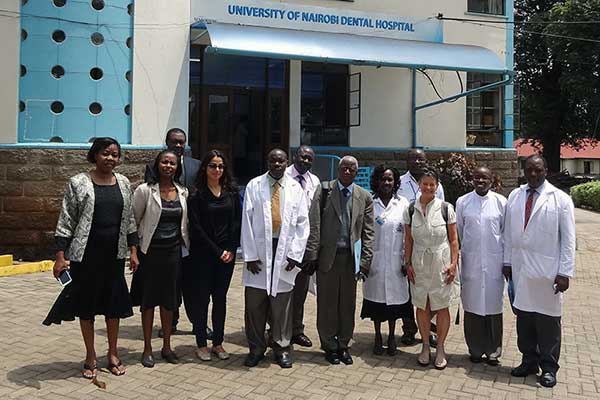
Helping solve Kenya's retinoblastoma challenge
Published: July 2, 2014
The potential to solve global health problems is limitless if you identify common goals, focus on mutual benefits and approach problems at a human level.
That's the outlook the University of Toronto's Helen Dimaras credits with helping her play an important role in saving 103 lives, training 145 caregivers and technicians and creating five new jobs in Kenya – all since 2012.
Dimaras, an assistant professor in the Department of Ophthalmology & Vision Sciences, is an expert in retinoblastoma, a rare eye cancer that affects infants and children. The tumor sometimes grows from the cells of a baby’s retina even before birth. A white glow in the eye – often visible in photographs of the child taken with a flash – is usually the first sign of retinoblastoma.
“We see about 24 new cases in Canada annually. Scientifically, this is a small sample size to research, making it more difficult to advance our treatment techniques,” says Dimaras. “In Kenya, East Africa’s medical training hub, there are over a hundred new cases annually. This is why it makes sense to work internationally to research and treat this cancer together for the benefit of all patients.”
One major challenge in Kenya is that affected children are often diagnosed later in life than in high-income countries. This gives the untreated cancer time to grow and spread outside the eye, leaving doctors with fewer options to cure the child. The sooner the cancer is diagnosed, the better the child’s chances are of not only surviving but also of retaining their vision.
In Canada, this is one of the most curable cancers with an approximately 95 per cent survival rate. In low- and middle-income countries, where most of the affected children live, the mortality rate from this cancer is up to 70 per cent. The larger number of cases in countries like Kenya, China and India is linked to higher birth rates.
Canadian experts such as Dimaras and Professor Brenda Gallie (pictured above), have been involved in the Kenya National Retinoblastoma Strategy network since it was founded in 2008. It connects Kenyan doctors, researchers, nurses, government officials, family members and adult survivors. Everybody in this group works together towards a common goal: to give affected children the best chance to survive and recover from this cancer.
The group’s initial task was to map the available resources to diagnose and treat retinoblastoma across Kenya. They found there were no adequate pathology mechanisms in place at the time: test results were often incomplete or inaccurate, and not promptly available to the doctors.
The solution to this challenge was creating a specialized retinoblastoma pathology lab at the University of Nairobi. In 2012, Dimaras and her Kenyan colleagues secured a Grand Challenges Canada grant supporting quality cancer pathology in Kenya. Toronto General Hospital also donated a microtome, a key component in the cancer pathology process. The funding and equipment helped the lab become an expert facility designated to receive every retinoblastoma specimen from across Kenya.
“We also streamlined referral systems in the government hospitals. Upon diagnosis, there is now a clear process to reach specialists for medical attention promptly,” says Brian Ouma, chief executive of Daisy’s Eye Cancer Fund Kenya, an international NGO that brings care to every child with retinoblastoma.
Providing quality pathology reports and making them available electronically is a breakthrough for retinoblastoma treatment across the country. A doctor in a remote area can instantly see digital images of a tumor to determine the need for more treatment.
The lab also provided research opportunities for Kenyan students. A University of Nairobi faculty member oversees lab operations and two Kenyan graduate students investigate the features of retinoblastoma specimens and analyze quality assurance.
Canadian students are also learning from the Kenyan experience. Third-year U of T medical student Seemi Qaiser is recording and analyzing the lab’s history. Her goal is to describe a practical model for creating similar centralized laboratories.
“We are sharing our expertise with our Kenyan colleagues who use it as they see appropriate within the particular context of their system,” says Qaiser. “In turn, they share their expertise with us. We are all learning.”
The success of the Kenyan strategy already prompted invitations from Ugandan, Ghanaian and Ethiopian specialists to get Kenyan experts’ help creating national strategies in those countries.
Still, challenges remain. The lab receives approximately 70 per cent of all Kenya’s retinoblastoma cancer specimens. It means that some affected patients may still not be benefitting from quality pathology and, therefore, may not be getting proper treatment. Other ongoing issues in Kenya include the need for sustainable funding for research, treatment and awareness efforts, as well as a lack of a robust support system for affected children and their families.
Dimaras hopes the Kenyan National Retinoblastoma Strategy’s continued efforts will help make quality care available across the country.
“If you harness the power of the local talented people, you can do amazing things. It is their country and they want to make things better. Our plan is focusing on expanding our coverage,” says Dimaras. “If we can make it work for retinoblastoma, we can provide quality pathology for other cancers in Kenya too.”
Vitaly Kazakov is a writer with the Faculty of Medicine at the University of Toronto.



